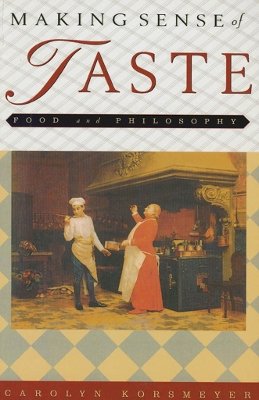10%OFF

Stock image for illustration purposes only - book cover, edition or condition may vary.
Making Sense of Taste: Food and Philosophy
Carolyn Korsmeyer
€ 36.99
€ 33.16
FREE Delivery in Ireland
Description for Making Sense of Taste: Food and Philosophy
Paperback. Num Pages: 240 pages, 18. BIC Classification: HBT; HPN; WBA. Category: (P) Professional & Vocational; (UP) Postgraduate, Research & Scholarly; (UU) Undergraduate. Dimension: 234 x 156 x 16. Weight in Grams: 370. Food and Philosophy. 272 pages, 15 b&w photographs, 3 drawings. Cateogry: (P) Professional & Vocational; (UP) Postgraduate, Research & Scholarly; (UU) Undergraduate. BIC Classification: HBT; HPN; WBA. Dimension: 234 x 156 x 16. Weight: 342.
Taste, perhaps the most intimate of the five senses, has traditionally been considered beneath the concern of philosophy, too bound to the body, too personal and idiosyncratic. Yet, in addition to providing physical pleasure, eating and drinking bear symbolic and aesthetic value in human experience, and they continually inspire writers and artists.In Making Sense of Taste, Carolyn Korsmeyer explains how taste came to occupy so low a place in the hierarchy of senses and why it is deserving of greater philosophical respect and attention. Korsmeyer begins with the Greek thinkers who classified taste as an inferior, bodily sense; she then ... Read more
Show LessProduct Details
Publisher
Cornell University Press
Number of pages
272
Format
Paperback
Publication date
2002
Condition
New
Weight
369g
Number of Pages
256
Place of Publication
Ithaca, United States
ISBN
9780801488139
SKU
V9780801488139
Shipping Time
Usually ships in 7 to 11 working days
Ref
99-1
About Carolyn Korsmeyer
Carolyn Korsmeyer is the author or editor of several books in aesthetics and philosophy of art, feminist philosophy, and emotion theory, including Savoring Disgust: The Foul and the Fair in Aesthetics (2011) and Things: In Touch with the Past (2019).
Reviews for Making Sense of Taste: Food and Philosophy
A book about how the divergent histories of taste and Taste have left us with an impoverished understanding of the former—and thus a deep skepticism about the aesthetic worth of food. Carolyn Korsmeyer suggests that her project will illuminate readers' understanding of food—and observes that it might well illuminate our understanding of art as well. She succeeds on both counts. ... Read more
